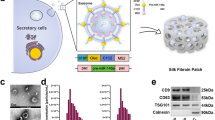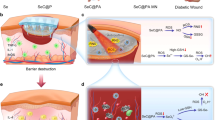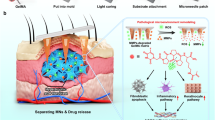Abstract
Matrix metalloproteinase (MMP)-assisted siRNA treatment was accomplished with a nanofibrous matrix for suicidal gene therapy of diabetic ulcers. We fabricated a MMP-responsive nanofibrous matrix to control release of small interfering RNA (siRNA) in response to a high concentration of MMPs in diabetic ulcers. For MMP-responsive release of siRNA, linear polyethyleneimine (LPEI) was chemically conjugated on the surface of the nanofibrous matrix via a MMP-cleavable linker. To control the abnormally elevated MMP-2 expression in diabetic ulcers, MMP-2 siRNA was electrostatically incorporated into LPEI-immobilized nanofibrous meshes with various nitrogen/phosphate (N/P) ratios. The release profiles of siRNA and LPEI were monitored to confirm that MMP responsiveness of the matrix and MMP-2 significantly increased the release of both siRNA and LPEI for 72 h. The released fractions were transfected to dermal fibroblasts. Quantitative reverse transcription (qRT)-PCR for endogenous MMP-2 expression confirmed that the gene-silencing effects of siRNA were dependent on the charge ratio of LPEI to siRNA on the mesh. Diabetic animals with dorsal burns were treated with siRNA-incorporated nanofibrous mesh for 7days. siRNA-incorporated nanofibrous meshes dramatically increased the MMP-2 gene-silencing effects of the siRNA and neo-collagen accumulation at the wound sites. RT-PCR also confirmed the highest expression levels of the keratinocyte-specific markers and the lowest expression levels of MMP-2 in the nanofibrous mesh-treated groups, suggesting that wound recovery is restored to normal levels. The wound recovery rates of diabetic ulcers were significantly increased when siRNA-incorporated nanofibrous meshes were administered. Thus, the suicidal treatment with the MMP-2 siRNA-decorated nanofibrous mesh is expected to improve prognosis of diabetic ulcers with reduced side effects.
This is a preview of subscription content, access via your institution
Access options
Subscribe to this journal
Receive 12 print issues and online access
$259.00 per year
only $21.58 per issue
Buy this article
- Purchase on Springer Link
- Instant access to full article PDF
Prices may be subject to local taxes which are calculated during checkout






Similar content being viewed by others
References
Boulton AJM, Vileikyte L, Ragnarson-Tennvall G, Apelqvist J . The global burden of diabetic foot disease. Lancet 2005; 366: 1719–1724.
Frykberg RG, Armstrong DG, Giurini J, Edward A, Kravette M, Kravltz S et al. Diabetic foot disorders: a clinical practice guideline. J Foot Ankle Surg 2000; 39: 54–60.
Apelqvist J, Larsson J, Agardh CD . Long-term prognosis for diabetic patients with foot ulcers. J Intern Med 1993; 233: 485–491.
Lobmann R, Ambrosch A, Schultz G, Waldmann K, Schiweck S, Lehnert H . Expression of matrix-metalloproteinases and their inhibitors in the wounds of diabetic and non-diabetic patients. Diabetologia 2002; 45: 1011–1016.
Lobmann R, Schults G, Lehnert H . Proteases and the diabetic foot syndrome: mechanisms and therapeutic implications. Diabetes care 2005; 28: 461–471.
Wysocki AB, Staiano-Coico L, Grinnell F . Wound fluid from chronic leg ulcers contains elevated levels of metalloproteinases MMP-2 and MMP-9. J Invest Dermatol 1993; 101: 64–68.
Yager DR, Chen S, Ward SI, Olutoye OO, Diegelmann RF, Cohen IK . Ability of chronic wound fluids to degrade peptide growth factors is associated with increased levels of elastase activity and diminished levels of proteinase inhibitors. Wound Rep Reg 1997; 5: 23–32.
Trengove NJ, Stacey MC, Macauley S, Bennett N, Gibson J, Burslem F et al. Analysis of the acute and chronic wound environments the role of proteases and their inhibitors. Wound Rep Reg 1997; 7: 442–452.
Lauer G, Sollberg S, Cole M, Flamme I, Stűrzebecher J, Mann K et al. Expression and proteolysis of vascular endothelial growth factor is increased in chronic wounds. J Invest Dermatol 2000; 115: 12–18.
Schultz G, Rotatori DS, Clark W . EGF and TGF-α in wound healing and repair. J Cell Biochem 1991; 45: 346–352.
Lee P, Li Z, Huang L . Thermosensitive hydrogel as a TGF-β1 gene delivery vehicle enhances diabetic wound healing. Pharm Res 2003; 20: 1995–2000.
Andree C, Swain WF, Page CP, Macklin MD, Slama J, Hatzis D et al. In vivo transfer and expression of a human epidermal growth factor gene accelerates wound repair. Proc Natl Acad Sci USA 1994; 91: 12188–12192.
Kim SH, Jeong JH, Lee SH, Kim SW, Park TG . PEG conjugated VEGF siRNA for anti-angiogenic gene therapy. J Control Release 2006; 116: 123–129.
Novina CD, Murray MF, Dykxhoorn DM, Beresford PJ, Riess J, Lee S et al. siRNA-directed inhibition of HIV-1 infection. Nat Med 2002; 8: 681–686.
Leachman SA, Hickerson RP, Hull PR, Smith FJD, Milstone LM, Lane EB et al. Therapeutic siRNAs for dominant genetic skin disorders including pachyonychia congenital. J Dermatol Sci 2008; 51: 151–157.
Reich SJ, Fosnot J, Kuroki A, Tang W, Yang X, Maguire AM et al. Small interfering RNA (siRNA) targeting VEGF effectively inhibits ocular neovascularization in a mouse model. Mol Vis 2003; 9: 210–216.
Medarova Z, Pham W, Farrar C, Petkova V, Moore A . In vivo imaging of siRNA delivery and silencing in tumors. Nat Med 2007; 13: 372–377.
Tan PH, Yang LC, Shih HC, Lan KC, Cheng JT . Gene knockdown with intrathecal siRNA of NMDA receptor NR2B subunit reduces formalin-induced nociception in the rat. Gene Therapy 2005; 12: 59–66.
Golzio M, Mazzolini L, Moller P, Rols MP, Teissie J . Inhibition of gene expression in mice muscle by in vivo electrically mediated siRNA delivery. Gene Therapy 2005; 12: 246–251.
Li JM, Newburger PE, Gounis M, Dargon P, Zhang X, Messina LM . Local arterial nanoparticle delivery of siRNA for NOX2 knockdown to prevent restenosis in an atherosclerotic rat model. Gene Therapy 2010; 17: 1279–1287.
Manaka T, Suzuki A, Takayama K, Imai Y, Nakamura H, Takaoka K . Local delivery of siRNA using a biodegradable polymer application to enhance BMP-induced bone formation. Biomaterials 2011; 32: 9642–9648.
Choi JS, Leong KW, Yoo HS . In vivo wound healing of diabetic ulcers using electrospun nanofibers immobilized with human epidermal growth factor (EGF). Biometerials 2008; 29: 587–596.
Choi JS, Choi SH, Yoo HS . Coaxial electrospun nanofibers for treatment of diabetic ulcers with binary release of multiple growth factors. J Mater Chem 2011; 21: 5258–5267.
Kim HS, Yoo HS . MMPs-responsive release of DNA from electrospun nanofibrous matrix for local gene therapy: In vitro and in vivo evaluation. J control Release 2010; 145: 264–271.
Mok H, Lee SH, Park JW, Park TG . Multimeric small interfering ribonucleic acid for highly efficient sequence-specific gene silencing. Nat Mat 2010; 9: 272–278.
Lee S, Huh MS, Lee S, Lee SJ, Chung H, Park JH et al. Stability and cellular uptake of polymerized siRNA (poly-siRNA)/polyethylenimine (PEI) complexes for efficient gene silencing. J control Release 2010; 141: 339–346.
Mehrotra S, Lee I, Chan C . Multilayer mediated forward and patterned siRNA transfection using linear-PEI at extended N/P ratios. Acta Biomater 2009; 5: 1474–1488.
Urban-Klein B, Werth S, Abuharbeid S, Czubayko F, Aigner A . RNAi-mediated gene-targeting through systemic application of polyethylenimine (PEI)-complexed siRNA in vivo. Gene Ther 2005; 12: 461–466.
Werth S, Urban-Klein B, Dai L, Höbel S, Grzelinski M, Bakowsky U et al. A low molecular weight fraction of polyethylenimine (PEI) displays increased transfection efficiency of DNA and siRNA in fresh or lyophilized complexes. J Control Release 2006; 112: 257–270.
Fougerolles A, Vornlocher H, Maraganore J, Lieberman J . Interfering with disease: a progress report on siRNA-based therapeutics. Nat Rev Drug Disc 2007; 6: 443–453.
Gao S, Dagnaes-Hansen F, Nielsen EJB, Wengel J, Besenbacher F, Howard KA et al. The effect of chemical modification and nanoparticle formulation on stability and biodistribution of siRNA in mice. Mol Ther 2009; 17: 1225–1233.
Doillon CJ . Porous Collagen Sponge Wound Dressings: in vivo and in vitro Studies. J Biomater Appl 1987; 2: 562–578.
Doillon CJ, Whyne CF, Berg RA, Olson RM, Silver FH . Fibroblast-collagen sponge interactions and the spatial deposition of newly synthesized collagen fibers in vitro and in vivo. Scan Electron Microsc 1984; 3: 1313–1320.
Burton JL, Etherington DJ, Peachey RD . Collagen sponge for leg ulcers. Br J Dermatol 1978; 99: 681–685.
Mattioli Belmonte M, Biagini G, Ricotti G, Zucchini C, Castaldini C, Fini M et al. Experimental wound dressing by heterologous collagen: a morphological-quantitative approach. J Bioact Compat Pol 1993; 8: 365–382.
Rhoa KS, Jeong L, Lee G, Seo B, Park YJ, Hong S et al. Electrospinning of collagen nanofibers: Effects on the behavior of normal human keratinocytes and early-stage wound healing. Biomaterials 2006; 27: 1452–1461.
Legrand C, Gilles C, Zahm J, Polette M, Buisson A, Kaplan H et al. Airway epithelial cell migration dynamics: MMP-9 role in cell-extracellular matrix remodeling. J Cell Biol 1999; 146: 517–529.
Salo T, Mäkelä M, Kylmäniemi M, Autio-Harmainen H, Larjava H . Expression of matrix metalloproteinase-2 and -9 during early human wound healing. Lab Invest 1994; 70: 176–182.
Mäkelä M, Larjava H, Pirilä E, Maisi P, Salo T, Sorsa T et al. Matrix metalloproteinase 2 (gelatinase A) is related to migration of keratinocytes. Exp Cell Res 1999; 251: 67–78.
Acknowledgements
This research was supported by the National Research Foundation of Korea (NRF) funded by the Ministry of Education, Science and Technology (grant# 2012005857).
Author information
Authors and Affiliations
Corresponding author
Ethics declarations
Competing interests
The authors declare no conflict of interest.
Additional information
Supplementary Information accompanies the paper on Gene Therapy website
Supplementary information
Rights and permissions
About this article
Cite this article
Kim, H., Yoo, H. Matrix metalloproteinase-inspired suicidal treatments of diabetic ulcers with siRNA-decorated nanofibrous meshes. Gene Ther 20, 378–385 (2013). https://doi.org/10.1038/gt.2012.49
Received:
Revised:
Accepted:
Published:
Issue Date:
DOI: https://doi.org/10.1038/gt.2012.49
Keywords
This article is cited by
-
An Overview on Wound Dressings and Sutures Fabricated by Electrospinning
Biotechnology and Bioprocess Engineering (2023)
-
Nanofiber-based systems intended for diabetes
Journal of Nanobiotechnology (2021)



